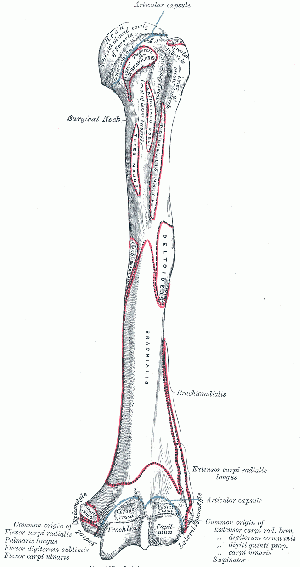Humerus: Difference between revisions
(added clinical relevance) |
mNo edit summary |
||
| Line 50: | Line 50: | ||
!Attachment | !Attachment | ||
|- | |- | ||
|Supraspinatus | |[[Supraspinatus]] | ||
|Greater Tubercle | |Greater Tubercle | ||
|- | |- | ||
|Infraspinatus | |[[Infraspinatus]] | ||
|Greater Tubercle | |Greater Tubercle | ||
|- | |- | ||
|Teres Minor | |[[Teres Minor]] | ||
|Greater Tubercle | |Greater Tubercle | ||
Upper Part of the Lateral Border | Upper Part of the Lateral Border | ||
|- | |- | ||
|Subscapularis | |[[Subscapularis]] | ||
|Lesser Tubercle | |Lesser Tubercle | ||
|- | |- | ||
| Line 70: | Line 70: | ||
Lateral Supracondylar Ridge | Lateral Supracondylar Ridge | ||
|- | |- | ||
|Brachioradialis | |[[Brachioradialis]] | ||
|Lateral Supracondylar Ridge | |Lateral Supracondylar Ridge | ||
|- | |- | ||
| Line 76: | Line 76: | ||
|Lateral Supracondylar Ridge | |Lateral Supracondylar Ridge | ||
|- | |- | ||
|Teres Major | |[[Teres Major]] | ||
|Crest of the Lesser Tubercle | |Crest of the Lesser Tubercle | ||
|- | |- | ||
|Coracobrachialis | |[[Coracobrachialis Muscle|Coracobrachialis]] | ||
|Crest of the Lesser Tubercle | |Crest of the Lesser Tubercle | ||
|- | |- | ||
|Brachialis | |[[Brachialis]] | ||
|Medial Supracondylar Ridge | |Medial Supracondylar Ridge | ||
|- | |- | ||
| Line 88: | Line 88: | ||
|Medial Supracondylar Ridge | |Medial Supracondylar Ridge | ||
|- | |- | ||
|Latissimus Dorsi | |[[Latissimus Dorsi Muscle|Latissimus Dorsi]] | ||
|Bicipital Groove | |Bicipital Groove | ||
|} | |} | ||
Revision as of 10:45, 23 March 2020
Description[edit | edit source]
Humerus is a long bone which consists of a shaft (diaphysis) and two extremities (epiphysis). It is the longest bone of the upper extremity.
Structure[edit | edit source]
Upper Extremity Features[edit | edit source]
The head of the humerus is the articular surface of the upper extremity, which is an irregular hemisphere.
The anatomical neck is the part between the head and the tuberosities.
The surgical neck is the part between the tuberosities and the shaft.
The greater tuberosity it is located lateral to the head.
The lesser tuberosity is located inferior to the head, on the anterior part of the humerus, Its very prominent and palpable.
Bicipital (intertubercular) groove is located between the two tuberosities. The Biceps tendon is placed here.
Body Features[edit | edit source]
The body of the humerus has three borders and three surfaces.
Borders[edit | edit source]
- Anterior
- Lateral
- Medial
Surfaces[edit | edit source]
- Antero-lateral
- Antero-medial
- Posterior
Function[edit | edit source]
The humerus serves as an attachment to 13 muscles which contribute to the movements of the hand and elbow, and therefore function of the upper limb.
Video[edit | edit source]
Articulations[edit | edit source]
Glenohumeral joint[2]
Elbow joint
Muscle Attachments[edit | edit source]
| Muscle | Attachment |
|---|---|
| Supraspinatus | Greater Tubercle |
| Infraspinatus | Greater Tubercle |
| Teres Minor | Greater Tubercle
Upper Part of the Lateral Border |
| Subscapularis | Lesser Tubercle |
| Pectoralis Major | Upper Part of the Anterior Border |
| Triceps Brachii | Lower Part of the Lateral Border
Lateral Supracondylar Ridge |
| Brachioradialis | Lateral Supracondylar Ridge |
| Extensor Carpi Radialis Longus | Lateral Supracondylar Ridge |
| Teres Major | Crest of the Lesser Tubercle |
| Coracobrachialis | Crest of the Lesser Tubercle |
| Brachialis | Medial Supracondylar Ridge |
| Pronator Teres | Medial Supracondylar Ridge |
| Latissimus Dorsi | Bicipital Groove |
Clinical Relevance[edit | edit source]
Proximal end or Head-Surgical Neck Fracture[3]
- It is caused by a direct blow on the area or fall on outstretched hand.
- It results in damage to Axillary nerve and Posterior circumflex artery.
- Axillary nerve damage results in paralysis of deltoid and teres minor muscles.
Shaft-Mid-shaft fracture[4]
- This fracture causes damage to radial nerve and Profunda brachii artery.
- Sensory loss can be seen over the dorsal surface of hand,proximal parts of lateral 3 and half fingers dorsally.
- Radial nerve palsy results in wrist drop.
Distal end-Supracondylar fracture[5]
- It is a fracture of distal humrus just above the Elbow joint.
- It results in damage to brachial artery and anterior interosseous nerve,the resulting ischemia causes Volkman's ischemic contracture.
Other conditions
- Haemotologic,infectious,genetic and neurological disorders cause humerus varus.[6]
- Charcot arthropathy is a rare disorder characterised by debilitating joint destruction.[7]
References[edit | edit source]
- ↑ http://www.bartleby.com/107/illus207.html
- ↑ Glenohumeral Joint
- ↑ https://teachmeanatomy.info/upper-limb/bones/humerus/#Clinical_Relevance_Surgical_Neck_Fracture
- ↑ https://teachmeanatomy.info/upper-limb/bones/humerus/#Clinical_Relevance_Mid-Shaft_Fracture
- ↑ https://teachmeanatomy.info/upper-limb/bones/humerus/
- ↑ https://www.ncbi.nlm.nih.gov/books/NBK534821/#
- ↑ https://www.ncbi.nlm.nih.gov/books/NBK534821/#
Gray H., 2000, Anatomy of Human Body, Twentieth Edition, New York, Bartleby.com







